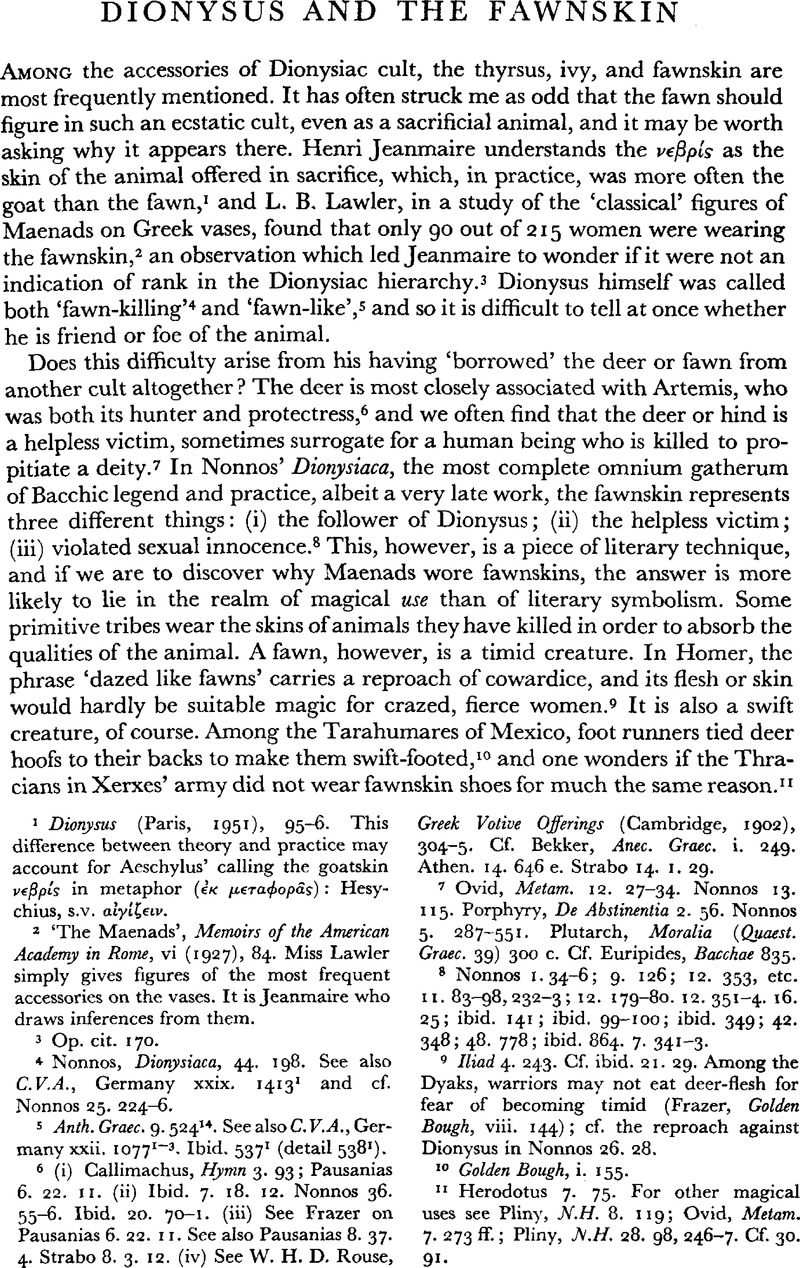Article contents
Dionysus and the Fawnskin
Published online by Cambridge University Press: 11 February 2009
Abstract

- Type
- Other
- Information
- Copyright
- Copyright © The Classical Association 1971
References
page 437 note 1 Dionysus (Paris, 1951), 95–6. This difference between theory and practice may account for Acschylus’ calling the goatskin νερς in metaphor (Éκ μεταφο03B1;ς): Hesy-chius, s.v. αίγίζειν.Google Scholar
page 437 note 2 ‘The Maenads’, Memoirs of the American Academy in Rome, 6 (1927), 84. Miss Lawler simply gives figures of the most frequent accessories on the vases. It is Jeanmaire who draws inferences from them.Google Scholar
page 437 note 3 Op. cit. 170.
page 437 note 4 Nonnos, Dionisiaca, 44. 198. See also C.V.A., Germany xxix. 14131 and cf. Nonnos 25. 224–6.
page 437 note 5 Anth. Graec. 9.52414. See also C.V.A., Germany xxii. 1077 1–3.Ibid. 537 1 (detail 538 1).
page 437 note 6 (i) Callimachus, Hymn 3. 93; Pausanias 6. 22. 11. (ii) IbidIbid. 7. 18. 12. Nonnos 36. 55–6. Ibid. 20. 70–1. (iii) See Frazer on Pausanias 6. 22. 11. See also Pausanias 8. 37. 4. Strabo 8. 3. 12. (iv) See Rouse, W. H. D., Greek Votive Offerings (Cambridge, 1902), 304–5Google Scholar. Cf. Bekker, , Anee. Grace, 1. 249. Athen. 14. 646 e. Strabo 14. 1. 29.Google Scholar
page 437 note 7 Ovid, Metam. 12. 27–34.Google Scholar Nonnos 13. 115. Porphyry, , De Abstinentia 2. 56Google Scholar. Nonnos 5. 287–551. Plutarch, Moralia (Quaest. Graec. 39) 300 c. Cf. Euripides, Bacchae 835
page 437 note 9 Iliad 4. 243. Cf. Ibid. 21. 29. Among the Dyaks, warriors may not eat deer–flesh for fear of becoming timid (Frazer, , Golden Bough, 8. 144)Google Scholar; cf. the reproach against Dionysus in Nonnos 26. 28.
page 437 note 10 Golden Bough, 1. 155.Google Scholar
page 437 note 11 Herodotus 7. 75. For other magical uses see Pliny, N.H. 8. 119; Ovid, , Metam. 7. 273 ff;Google Scholar. Pliny, , N.H. 28. 98, 246–7Google Scholar. Cf. 30. 91.
page 438 note 1 S.v. ἒλαφος, 326,
page 438 note 2 Moralia(De sollertia animalium 24) 976 d.
page 438 note 3 Cynegetica 2. 233–50. Translation by A. W. Mair (Loeb edn.), who also gives further references. Cf. Lucretius 6. 765–6.
page 438 note 4 Isidore, Etym. 12. 1. 18 = Migne, P.L. Ixxxii, col. 427.
page 438 note 5 I am grateful to Dr. R. V. Short to whom I owe this explanation of the deer’ behaviour and the description of it.Google Scholar
page 439 note 1 This may not have been confined to the early days of the cult. Cf. Clement of Alexandria: ‘The Bacchanals hold their orgies in honour of the frenzied Dionysus … crowned with snakes etc.’ (Cohortatio ad Gentes II, Migne, P.G. 8, col. 72). Cf. the Hellenistic pageant described by Athen. 5. 198 e. The snakes here, however, may not have been real.Google Scholar See also C.V.A., Germany 12. 5771 and 578–81, which show details.Google Scholar
- 2
- Cited by


